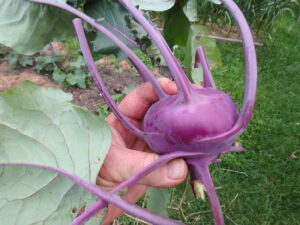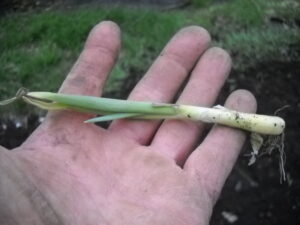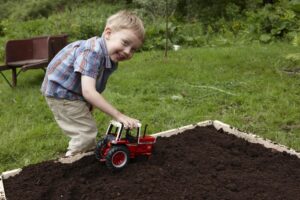Plan to Grow Winter Vegetables
Posted on Sunday, January 2, 2022 · Leave a Comment
I am probably not the only person who is determined to lose a little weight after all those delicious but fattening meals and desserts served up over the holidays. One way to feel satisfied and lose weight is to eat more salads and enjoy more vegetables. That’s my plan, anyway, and I recently took stock of what is lingering on in my storage fridge. I still have some nice veggies from summer that still taste good and are satisfying my hunger.

Try growing Kohlrabi this summer.They’re tasty and keep well
Digging around the vegetable drawer I noticed several kohlrabi I grew last summer, but had not been touched in months. I was prepared not to like them because they had been stored so long. I peeled one, chopped it into half-inch cubes, and added to my nightly salad. It was delicious! It’s even tasty as low calorie snack food just by itself.
Kohlrabi is in the cabbage family, but not well known or much grown, It looks like a space alien in the garden: it is an above-ground root vegetable of sorts. Round or oblong, it can be green or purple, with leaves poking out of the beet-like “tuber” on bare stems. It is crunchy, and tastes a bit like broccoli, which is in the same family. It can be used to make coleslaw when grated with carrots.
Buy a packet of kohlrabi seeds and plant them in early June or late May. They are fast-growing plants and only need a bit of space to grow well. If you want kohlrabi all winter for adding to stir fries, plant a green one called ‘Kossak’ which gets large – up to 8- or 10-inches in diameter – and stores for up to 4 months in a cool, high humidity place like the vegetable drawer our your fridge. I get seeds from Johnny’s Selected Seeds in Maine, but it is also available from High Mowing, Gurney’s and Park Seeds, among others.
I also found half a purple cabbage that had been lurking in my vegetable drawer since September. I expected it to be stale, but it was fine. Cabbage is easy enough to grow, but I often don’t bother because I don’t use it much – it is cheap and readily available. I grated some and added it to a green salad, adding color and bulk.

Onions are sold as plants which grow better than onion sets, or little bulbs
I had a great onion crop last summer. I buy onion plants from Johnny’s Seeds most years instead of babying seed-started plants indoors. When I start from seed, I start them under lights around March 1. When I start my own, even with intense light close to the seedlings, they are always a bit flimsy. Some of the plants I get from Johnny’s are nearly as thick around as a pencil, and take off and start growing immediately. The kind I grow are yellow onions, one called ‘Patterson’. They keep for months in a cool location, but will sprout and soften if left in the warm kitchen in a bowl.
The plants come in bundles of 50 to 60, according to their catalog, but last year I got closer to 100 plants per bundle. Onions don’t like competition, so weed early and often. Space your onions about 3 inches apart in the row, with rows at least 8 inches apart. They like fluffy, rich soil so be sure to add lots of compost and stir it in well. You can also start onions from “sets”, which are like little bulbs – but less vigorous than plants.
What else am I eating from the garden now? Garlic. It is easy to grow, but if you didn’t plant any last October, you’re probably out of luck. It sets its roots in the fall, goes dormant, and pops up early in the spring. It is rarely available to purchase in the spring. I was out in California one spring and bought some soft-necked garlic in the spring, and it did fairly well here. You could try planting some of last year’s garlic, come spring, if you have any left over but it’s not recommended.
Potatoes are also a mainstay of my winter menu. I know, they are not usually recommended for dieters. But that is partly because of how they are served. They are a healthy starch, but many of us tend to load up potatoes with sour cream or butter. Add them to a stew or stir fry, and they are still tasty but much less calorific.
I went 20 years once without buying a potato. I grew plenty, and saved out some for planting each spring. By only eating my own, I went a few months without any while waiting for my new crop to be ready. But it was a matter of principle to only eat my own. Commercial potatoes, if not raised organically or following IPM guidelines, can carry heavy pesticide loads.
The trick to getting lots of potatoes is to grow them in full sun. You can get potatoes where there is only 6 hours of sun per day, but the more sun, the more potatoes. And don’t let the potato beetles defoliate your plants. Check leaves, including the underneath side, for orange egg masses or larvae often when they are starting to grow. They can multiply exponentially if you let early beetles multiply.

Gardens aren’t just for food. They can be for fun too.
Having a vegetable garden is, of course, a certain amount of work. But it provides me not only with good, healthy, organic veggies, it saves me lots of money and keeps me active in the garden. As we get older, the more exercise we get, the better. So start reading the catalogs or websites of seed companies, and plan what you will plant, come spring. Me? I can’t wait!
Henry lives and
gardens in Cornish Flat, NH. He is the author of 4
gardening books. You can reach him by email at
henry.homeyer@comcast.net.





